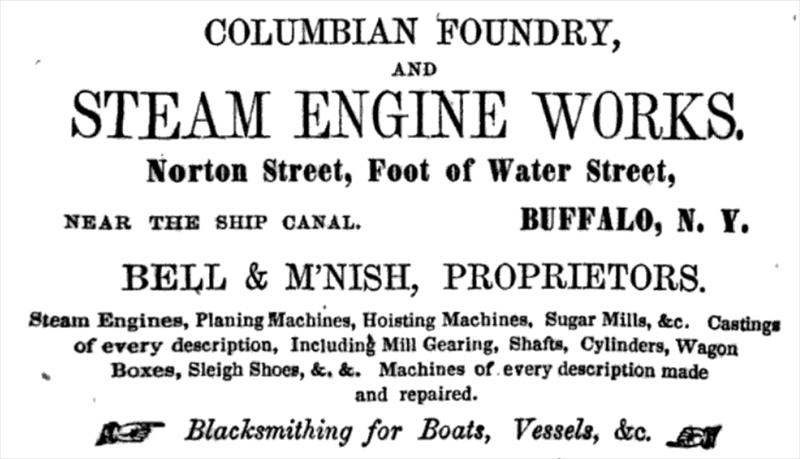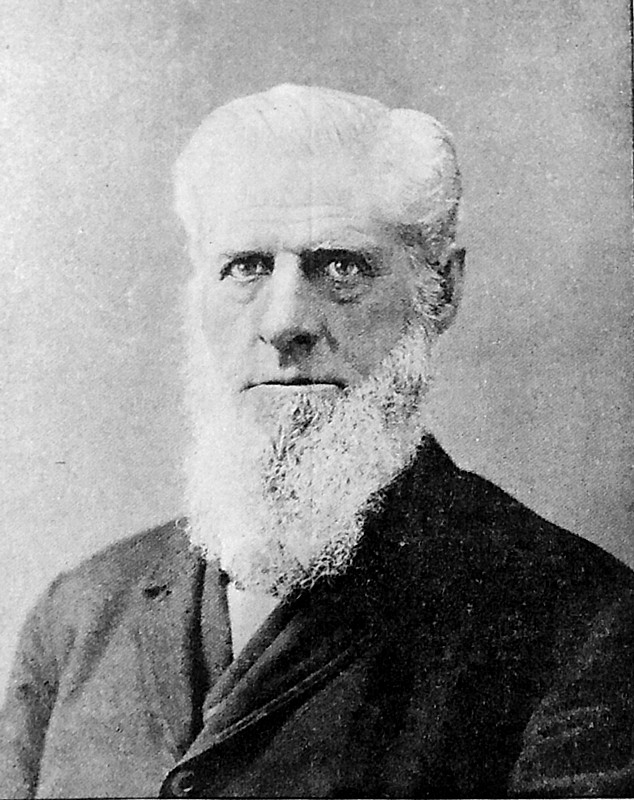 |
| From 1848-50 Buffalo Commercial Advertising Directory |
In 1845 David Bell and William McNish began making steam engines and machinery in a small building on Norton Street, which they named the Columbian Foundry and Steam engine Works. They partnership operated as Bell & M'Nish. By 1848 they were making steam engines, "planing machines" (whether for wood or metal is unclear), and mill machinery. In 1850 McNish left the business and the business continued as David Bell. After a fire destroyed the Works, Bell built a larger building to replace it. Although the business was not a major commercial success—a 1911 biography of Bell all but says that he was not a good businessman—the business survived and earned respect for his achievements: locomotive building, the first iron propeller on the lakes, the first fireboat in Buffalo.

David Bell
Image courtesy of Brian Szafranski
At some point the business became the David Bell Engineering Works. David Bell, Jr., took over operation of the business. In 1907 the business was acquired by the Buffalo Foundry Co., with the merged business operating as the Buffalo Foundry & Machine Co. See that entry for the continuation.
Information Sources
- A 1902 lawsuit provides some insight into the operation of the David Bell Engineering Works at that time.
- A History of Buffalo by the Progress of the Empire State Co. 1911, page 2.
In 1842 David Bell, a Scotch machinist and mechanical engineer, came to Buffalo and found employment at the Buffalo Steam Engine Works, then lately brought into operation. In 1845 he joined William McNish in starting a small plant for the same business. The partnership was dissolved in 1850 and David Bell continued it alone. A few years later his works were burned, just after the expiration of insurance, and he began anew with little to capitalize his undertaking except the stuff of courageous energy in himself. He not only rebuilt his works, but also enlarged their scale. In business management he could hardly be called successful; but he kept his feet, and was always at the front of new ventures in his line. He built the "Merchant," the first iron propeller on the lakes. He began locomotive building in 1865. He constructed for the city its first fireboat, in 1887. He was full of enterprise to the end of his life, and the David Bell Engineering Works, which survived him, were merged, in 1907, in the Buffalo Foundry and Machine Company, of which some account will be given later on.
- 1907-09-12 The Iron Age.
The Buffalo Foundry Company, Buffalo, N. Y., has taken over the business of the David Bell Engineering Works of that city, manufacturer of the David Bell steam hammers, &c., and will hereafter conduct the consolidated business of the two companies under the name of the Buffalo Foundry & Machine Company. A large machine shop will be erected by the Buffalo Foundry & Machine Company adjoining its present foundry at East Ferry street, Fillmore avenue and the New York Central Belt Line, and in addition to doing a general foundry and machine shop business it will make a Specialty of the manufacture of the David Bell steam hammers, vacuum dryers and impregnators and other appliances. Henry D. Miles, president, and Michael Sullivan, vice-president, of the Buffalo Foundry Company, will continue to hold the same offices with the consolidated company, and David Bell, formerly vice-president and general manager of the David Bell Engineering Works, will be superintendent of the machine shop department.
- 1907-09-26 The Iron Age.
The Buffalo Foundry & Machine Company, Buffalo, N. Y., which was recently formed to take over the business of the Buffalo Foundry Company and the David Bell Engineering Works, will erect a new machine shop, 160 ft. long, the main bay to be 64 ft. wide, with 40 ft. clearance under the crane, and the side bay to be 30 ft. wide, with 15 ft. clearance under the crane. Provision has been made for the installation of a gallery on the side floor later. The company has not yet determined upon the machinery it will require for equipping the new building. The building will be erected adjoining the present foundry at East Ferry street, Fillmore avenue and the New York Central Belt Line, and will be used to a great extent for the manufacture of the David Bell steam hammers, vacuum dryers, impregnators, &c.